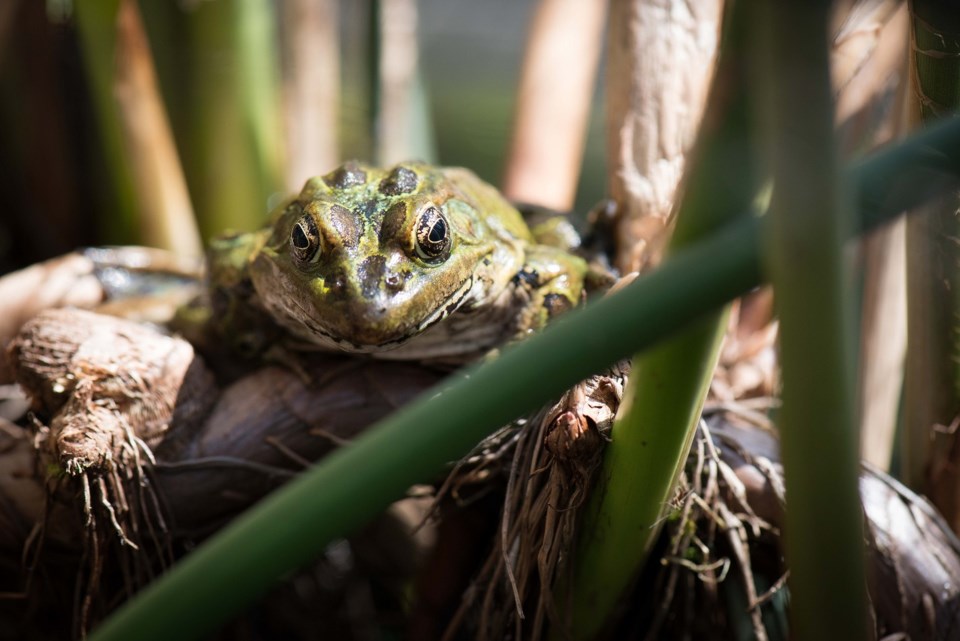More than 1,600 endangered Northern leopard frog tadpoles raised at Vancouver Aquarium®, an Ocean Wise® initiative, were released into a natural habitat in the Kootenays on Wednesday, June 6, 2018. This is the sixth consecutive breeding year for the conservation program that aims to boost the wild population of the Northern leopard frog – the most endangered amphibian in British Columbia – and the second largest number of tadpoles produced in a single year. In collaboration with the Northern Leopard Frog Recovery Team, Vancouver Aquarium has raised and released more than 7,100 Northern leopard frog tadpoles since 2013.
“This year was a banner year for our Northern leopard frog conservation program and we couldn’t be more pleased. We added two large frog ponds to the existing three and, as a result, saw improved breeding, more fertilised egg masses, and more tadpoles,” said Kris Rossing, senior biologist at Vancouver Aquarium. “We know that changes in environment impact Northern leopard frogs and their reproductive cycles both in the wild and here at the Aquarium; this results in varying numbers of egg masses and tadpoles produced. Every year we learn more and more about these frogs and their reproductive needs which helps us continually refine our propagation practices and maximize the impact of our conservation efforts.”
For the past six years, Northern leopard frogs produced at the Vancouver Aquarium have been dedicated to re-establishing a population in a natural habitat near Brisco, B.C. For the past two years, the Recovery Team has heard adult males calling at this release site; this is a positive indication that the frogs are surviving winter and reaching sexual maturity, and that the program is successful in helping the vulnerable Rocky Mountain population.
Early morning on June 6, the tadpoles were diligently transported to the Kootenays, first by car to YVR then by plane to Cranbrook, B.C. Received by members of the Recovery Team, the tadpoles were then transported by car for an additional two hours, and then by kayak to their new home in the marshy wetlands along the Columbia River near the Alberta border.
Vancouver Aquarium was the first aquarium to breed the amphibians as part of an assurance population and is part of a worldwide effort, along with other zoos and aquariums, to conserve this and other amphibian species under the Amphibian Ark (AArk) project.
A key component of the propagation process involves a collaboration with Dr. Vance Trudeau at the University of Ottawa and the use of a hormone treatment he created called Amphiplex. The treatment, which is a painless injection into the frogs, has been used to help induce spawning and spur the animals into amplexus — when the male mounts and holds the female frog to induce ovulation and then fertilises the eggs as they are laid.
Beginning in the 1970s, populations of Northern leopard frogs across western Canada declined by the millions, making them one of the most at-risk amphibian species, especially in B.C. Research continues into the cause of these sharp declines in the Rocky Mountain population of the Northern leopard frogs. The Rocky Mountain population that occurs in B.C. is listed as Endangered by the Committee on the Status of Endangered Wildlife in Canada (COSEWIC) and is on the provincial Red List.
Once found at many sites in the Kootenay and Okanagan regions, the Rocky Mountain population began to decrease to a point where only one wild population, in Creston Valley, existed. In 2004, a second population was reintroduced in the Upper Kootenay Floodplain, near Bummers Flats. A third population was reintroduced in 2013 at a site in the Columbia Marshes with tadpoles produced at Vancouver Aquarium as part of the recovery effort for this species.



